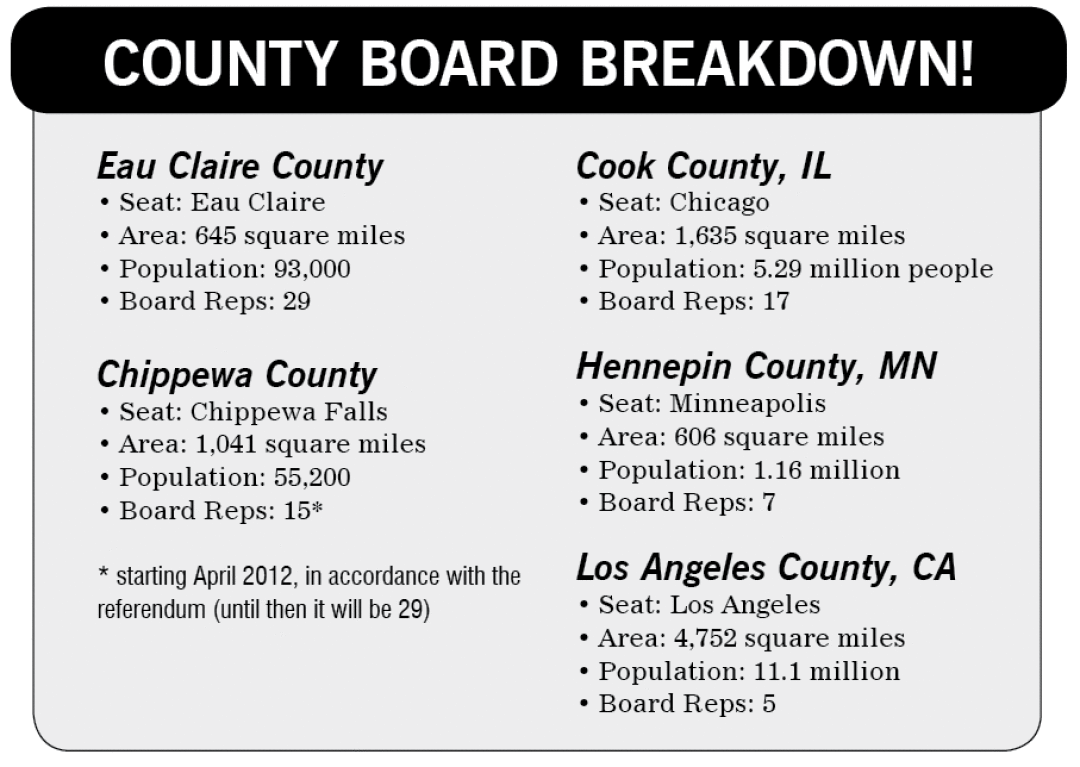County, I Shrunk the Board
how one man’s petition made us rethink county board sizes
After a county-wide referendum on Nov. 2, the Chippewa County Board was reduced from 29 supervisors to just 15, and it’s possible the same could happen to the Eau Claire County Board, whether its members like it or not. But what will this mean for Chippewa? Is this a good thing, or something we should avoid?
Chippewa Falls resident Don Sperber was dissatisfied with the size of the county board (which he formerly served on), and last fall started a petition to reduce it. He successfully obtained the proper number of signatures, which elevated his petition to a referendum on the Nov. 2 ballot.
Seventy-three percent of residents voted for the reduction, and it passed. Consequently, by April 2012, the supervisors must make the required reductions as well as reassign duties and responsibilities among the county board to fulfill the wishes of the residents.

This reduction looms in the back of the minds of Eau Claire County Board Supervisors (also a 29-member board) who fear a similar action may occur. So instead of waiting for a resident to get a petition together, the board is deciding for themselves how many seats to cut. The debate is over the magic number, as no one wants to jeopardize the representation of their constituents.
According to Supervisor Howard Ludwigson, the reduction should be down to the teens, while Supervisor Bruce Willett says the reduction should be down to 22. No matter the number, however, the supervisors already agree that a reduction must take place. So what are some of the pros and cons that come with a reduction?
For starters, the most obvious drawback is that more work must be divided among fewer members. First Vice Chairman Henry Shakal reports that the time constraints would become too demanding and would discourage those with full-time jobs to apply for a seat. As of right now, the Eau Claire County Board is mainly made up of retired residents who can devote the time to the position without feeling the time constraints of a regular job as well. As a result, there is a loss in age diversity within the board.
Secondly, reducing the size of the board ultimately means there would be fewer voices standing up for the issues. The chairman of the Wisconsin Towns Association, Rick Stadleman, says, “I believe it gives the department heads more control,” adding that there’s a risk of disproportionately representing rural areas. However, others maintain that board seats represent people, not land.
“Supervisors can represent more people,” Sperber said, adding that we now have technological advances that make communication increasingly easier.
“I’ve had a lot of pats on the shoulder and a lot of criticism for this,” Sperber said.
Another negative aspect of shrinking a board’s size is that the action is permanent according to state law. So if we decided to go down to 15 seats and later realized 20 seats (or even 16) are needed to properly represent residents, it couldn’t be undone. The board must remain that size or get even smaller.
While some supervisors are positive a reduction similar to Chippewa’s would be a bad move for Eau Claire, others believe it can only be a step up. With fewer members on the board there would be fewer supervisors to pay, and some (like Sperber and Supervisor Bill Secraw) believe that’s reason enough to make significant cuts. But that’s not the only reason. Some believe the board can be half the size and still fulfill its duties. A large county board is unnecessary and wasteful, in Sperber’s opinion.
Wisconsin is one of the few states that have adopted a state government model with more than a dozen members representing counties. John Reinemann, legislative director of the Wisconsin Counties Association, explains that it is possible to have a successful county board that has only five to seven members. Minnesota is a prime example.
So in the coming months, while the Chippewa County Board is debating how to change duties and positions with about half as many seats, Eau Claire County supervisors will be contemplating how many seats it takes to efficiently represent a county.
“I’ve had a lot of pats on the shoulder and a lot of criticism for this,” Sperber said. “But I think it’s something that should happen throughout the whole state.”




















